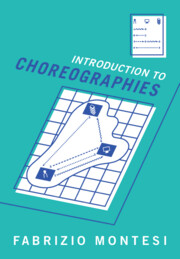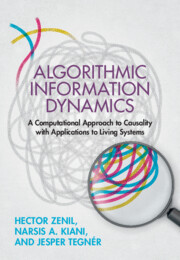Refine search
Actions for selected content:
48285 results in Computer Science

Introduction to Choreographies
-
- Published online:
- 11 May 2023
- Print publication:
- 25 May 2023

Algorithmic Information Dynamics
- A Computational Approach to Causality with Applications to Living Systems
-
- Published online:
- 11 May 2023
- Print publication:
- 25 May 2023
29 - On the Computational Content of Choice Principles
- from Part VI - Aspects of Computation
-
- Book:
- Handbook of Constructive Mathematics
- Published online:
- 04 May 2023
- Print publication:
- 11 May 2023, pp 806-825
-
- Chapter
- Export citation
23 - An Introduction to Constructive Reverse Mathematics
- from Part V - Logic and Foundations
-
- Book:
- Handbook of Constructive Mathematics
- Published online:
- 04 May 2023
- Print publication:
- 11 May 2023, pp 636-660
-
- Chapter
- Export citation
20 - The Minimalist Foundation and Bishop’s Constructive Mathematics
- from Part V - Logic and Foundations
-
- Book:
- Handbook of Constructive Mathematics
- Published online:
- 04 May 2023
- Print publication:
- 11 May 2023, pp 525-563
-
- Chapter
- Export citation
16 - Subspaces in Pointfree Topology: Towards a New Approach to Measure Theory
- from Part IV - Topology
-
- Book:
- Handbook of Constructive Mathematics
- Published online:
- 04 May 2023
- Print publication:
- 11 May 2023, pp 426-444
-
- Chapter
- Export citation
5 - Constructive Algebra: The Quillen–Suslin Theorem
- from Part II - Algebra and Geometry
-
- Book:
- Handbook of Constructive Mathematics
- Published online:
- 04 May 2023
- Print publication:
- 11 May 2023, pp 114-149
-
- Chapter
- Export citation
Part II - Algebra and Geometry
-
- Book:
- Handbook of Constructive Mathematics
- Published online:
- 04 May 2023
- Print publication:
- 11 May 2023, pp 91-92
-
- Chapter
- Export citation
24 - Systems for Constructive Reverse Mathematics
- from Part V - Logic and Foundations
-
- Book:
- Handbook of Constructive Mathematics
- Published online:
- 04 May 2023
- Print publication:
- 11 May 2023, pp 661-699
-
- Chapter
- Export citation
28 - Efficient Algorithms from Proofs in Constructive Analysis
- from Part VI - Aspects of Computation
-
- Book:
- Handbook of Constructive Mathematics
- Published online:
- 04 May 2023
- Print publication:
- 11 May 2023, pp 777-805
-
- Chapter
- Export citation
13 - A Leisurely Random Walk Down the Lane of a Constructive Theory of Stochastic Processes
- from Part III - Analysis
-
- Book:
- Handbook of Constructive Mathematics
- Published online:
- 04 May 2023
- Print publication:
- 11 May 2023, pp 333-356
-
- Chapter
- Export citation
Preface
-
- Book:
- Handbook of Constructive Mathematics
- Published online:
- 04 May 2023
- Print publication:
- 11 May 2023, pp xvi-xx
-
- Chapter
- Export citation
14 - Bases of Pseudocompact Bishop Spaces
- from Part IV - Topology
-
- Book:
- Handbook of Constructive Mathematics
- Published online:
- 04 May 2023
- Print publication:
- 11 May 2023, pp 359-394
-
- Chapter
- Export citation
Part IV - Topology
-
- Book:
- Handbook of Constructive Mathematics
- Published online:
- 04 May 2023
- Print publication:
- 11 May 2023, pp 357-358
-
- Chapter
- Export citation
9 - Constructive Functional Analysis
- from Part III - Analysis
-
- Book:
- Handbook of Constructive Mathematics
- Published online:
- 04 May 2023
- Print publication:
- 11 May 2023, pp 221-254
-
- Chapter
- Export citation
18 - Apartness on Lattices and Between Sets
- from Part IV - Topology
-
- Book:
- Handbook of Constructive Mathematics
- Published online:
- 04 May 2023
- Print publication:
- 11 May 2023, pp 483-512
-
- Chapter
- Export citation
Part III - Analysis
-
- Book:
- Handbook of Constructive Mathematics
- Published online:
- 04 May 2023
- Print publication:
- 11 May 2023, pp 199-200
-
- Chapter
- Export citation
ON THREE-VALUED PRESENTATIONS OF CLASSICAL LOGIC
- Part of
-
- Journal:
- The Review of Symbolic Logic / Volume 17 / Issue 3 / September 2024
- Published online by Cambridge University Press:
- 11 May 2023, pp. 682-704
- Print publication:
- September 2024
-
- Article
- Export citation
1 - An Introduction to Intuitionistic Logic
- from Part I - Introductory
-
- Book:
- Handbook of Constructive Mathematics
- Published online:
- 04 May 2023
- Print publication:
- 11 May 2023, pp 3-19
-
- Chapter
- Export citation










